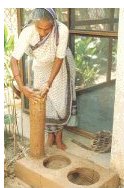

Bangladesh 
 |
Wood Energy Situation Policies and Programmes Wood Energy Data Further Reading RWEDP Focal Points |
Wood Energy Situation
Bangladesh is one of the RWEDP-member countries with the smallest area of natural forest (5.4% of total land area in 1995). Per capita income is only just over US$200 per year. Biomass energy, consisting of fuelwood, agricultural residues and dung dominates primary energy production and supply in Bangladesh. In 1994, 141 PJ of fuelwood and 363 PJ of other biomass energy was consumed, mainly in the household sector. Seventy one percent and 20% of the total energy consumed came from biomass and woodfuels respectively. Between 1983 and 1994, fuelwood consumption grew with an average annual growth rate of 1.3%, compared to 9% for conventional energy.
As much as 87% of all woodfuels originate from sources other than forests, but severe scarcities prevail almost all over the country.
Policies and Programmes
 The Forestry Department under the Ministry of Environment and Forests is now focussing on tree growing on agricultural and wasteland, and co-ordination with the Ministry of Agriculture is being strengthened. Afforestation is also being undertaken in mangrove forests, although this is not meant for fuel production. Participatory forestry programmes have proved successful in establishing degraded and encroached forest land and new forestry policies aim to extend the efforts. The Department of Forestry is also interested in densification technologies for fuel briquettes since agri-residues are a major fuel source. Attempts are being made to increase fuelwood production, but the impact has been only limited.
The Forestry Department under the Ministry of Environment and Forests is now focussing on tree growing on agricultural and wasteland, and co-ordination with the Ministry of Agriculture is being strengthened. Afforestation is also being undertaken in mangrove forests, although this is not meant for fuel production. Participatory forestry programmes have proved successful in establishing degraded and encroached forest land and new forestry policies aim to extend the efforts. The Department of Forestry is also interested in densification technologies for fuel briquettes since agri-residues are a major fuel source. Attempts are being made to increase fuelwood production, but the impact has been only limited.
There have been talks about the effectiveness of the law regarding (fuel)wood issues. For instance, the regulation that for every tree cut three have to be planted cannot be implemented. Neither can the ban on fuelwood use in brick making industries be enforced. Moreover, there is some uncertainty about whether the fuelwood market should be constrained rather than encouraged.
The overall technological infrastructure of the country is still relatively weak. The Bangladesh Council for Scientific and Industrial Research (BCSIR) and its Institute for Fuel Research and Development (IFRD), which was one of the RWEDP Focal Points, may be strong in basic research, however, it could still strengthen it's applied research. The IFRD is actively involved in stove research and development as well as guiding a national stove programme.
Wood Energy Data
| General | |||||
| Population (1996) | 120 mln. | ||||
| Share of Rural Population | 81.1% | ||||
| GDP per capita (1995) in constant 1987 US$ | 202 | ||||
| Energy Consumption (1994/95) | |||||
| Total Final Energy Consumption in PJ | 845.1 | ||||
| Consumption of Wood Energy in PJ | 143.7 | (17.0%) | |||
| Consumption of Biomass Energy in PJ | 563.4 | (66.7%) | |||
| Wood Energy Resources | |||||
| Forest Area (1995) in 1000 ha | 1,010 | (7.8%) | |||
| Natural Forest Area (1995) in 1000 ha | 700 | (5.4%) | |||
| Agricultural Area (1994) in 1000 ha | 9,400 | (72.2%) | |||
| Share of Woodfuels from Forest Area (1981) | 13% | ||||
| Potential Wood Energy Supply (1994) | |||||
| Sust. Supply from Natural Forest in kton | 737 | ||||
| Sust. Supply from Forest Plantations in kton | 1,028 | ||||
| Sust. Supply from Agriculture Areas in kton | 5,593 | ||||
| Sust. Supply from Other Wooded Land in kton | 215 | ||||
| Supply from Wood Waste from Deforestation in kton | 1,426 | ||||
| Total Potential Supply in kton | 8,999 | ||||
| Primary Wood Energy Requirements in kton | 9,396 | ||||
Notes:
Population and land use data from FAO (FAOSTAT), GDP per capita from World Bank. Energy consumption data from various sources.
Potential wood energy supply estimated by RWEDP, based on available data for land use, wood productivity and estimates on availability of wood for energy use. For forest land, other wooded land and agriculture areas, the potential supply is based on average annual yield estimates, assuming a sustainable use of resources (Sust.: sustainable). Wood waste from deforestation refers to wood potentially available from natural forest land cleared due to commercial logging, expansion of agriculture land or other reasons. The estimates are based on aggregated national data, which can hide local variations, ranging from scarcity to abundance. For detailed calculations and estimates for 2010, see FD50, chapter 8
Further reading:
| Woodfuel in Bangladesh - Production and Marketing - Technical Papers from the National Training Course, Bogra. RWEDP Report 38, 1998 | |
| Regional Study on Wood Energy Today and Tomorrow in Asia, Field Document 50, 1997 | |
| Chapter 2 in Review of Wood Energy Data in RWEDP Member Countries, Field Document 47, 1997 | |
| Proceedings of The National Workshop in Bangladesh on Wood-Based Energy Systems for Rural Industries and Village Applications, RWEDP Report 34, 1997 | |
| Biomass Based Energy Systems in Rural Industries and Village Applications - Bangladesh. Field Document 17, 1989 |
RWEDP Focal Points in Bangladesh
Focal points are the main contacts for RWEDP in a member country. Generally, in each country, there is one focal point in the energy sector, and one in the forestry sector.
| Industry and Energy Division Planning Commission, Ministry of Planning Block 13 Room 15, Sher-e-Banglanagar Dhaka 1207 TEL: 880-2-9116492 FAX: 880-2-817581 | Chief Conservator of Forests Forest Department Bana Bhaban Gulshan Road, Mohakhali Dhaka 12 TEL: 880-2-881484/883633 FAX: 880-2-605923 |
Comments, questions? webmaster@rwedp.org
© FAO-RWEDP, 1999